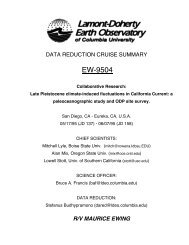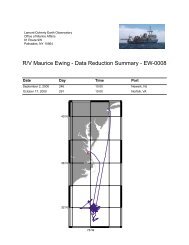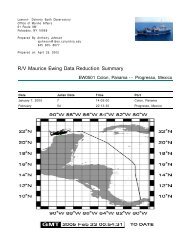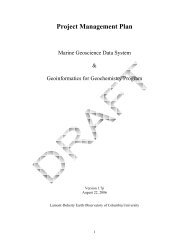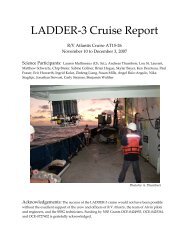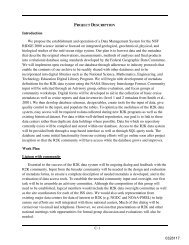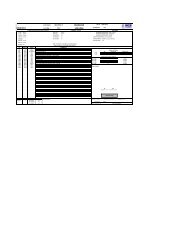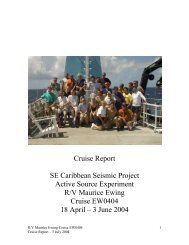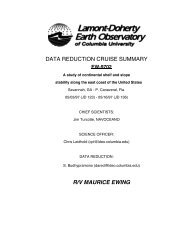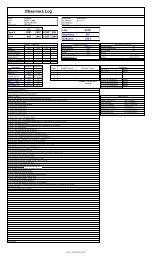mentioned, clearly defined gap layers were observed less frequently than for summer sea ice in the Weddelland Bellingshausen Seas, although evidence for high primary productivity in the upper portion of ice coressuggest that similar features (i.e., favourable growth habitats) were present but that perhaps the gap layerswere now mostly semi-consolidated.Ice cores were composed primarily of granular ice (e.g. Figure 26). Clear evidence for thick layers (> 10cm) of snow ice were observed in a limited number of ice cores. All but one core showed clear evidencefor deformational thickening. While congelation ice was observed in most cores, in only one case was acontinuous, undeformed layer greater than 20 cm observed. Superimposed ice crystals were frequentlyobserved, but clear layers with large polygonal grains (suggestive of substantial snow melt) averaged only afew centimeters thick.While much of the ice is expected to be first-year based on very light ice conditions observed in the Amundsenand Bellingshausen Seas the previous summer, this was difficult to confirm, even from surface appearance (i.eangular ridges). In several cores initially thought to be from floes less than a year old refrozen melt featureswere found. It is unlikely that large voids formed during this summer would have refrozen, indicating thatthis occurred at the end of the previous summer. This further suggests that much of the multiyear ice inthe Amundsen Sea may be advected in from the Western Bellingshausen.Taken together, these observations suggest the following preliminary assessment of the summer ice regime:• Initial ice formation in the Amundsen Sea was primarily through frazil/pancake ice formation.• Ice deformation is the primary means of thickening for ice that survives into the summer.• Surface snowmelt is relatively minor, particularly compared to previous observations in the southeasternBellingshausen Sea.• Snow ice formation is modest prior to summer. However, by the end of summer flooding is widespreadand snow remains deep, so snow ice formation can be expected to cause significant thickening ofmultiyear ice.Summer sea ice thinning and retreat is then controlled primarily by ice drift variability and disposition ofsolar energy in the ocean. A key question is how change or variability in snow accumulation or summersurface melt processes might affect ice thickness and modulate sea ice response to climate variability. <strong>Data</strong>collected by the ice mass balance buoys described below is expected to help answer this question.5.3 Methods and CaveatsASPeCt Ice Observations and Automated Camera SystemHourly observations of sea ice conditions were carried out while the ship was operating in ice using thestandard Antarctic Sea Ice Processes and Climate (ASPeCt) protocol (Worby, 1999). The hourly observationsrelied heavily on a handful of intrepid volunteers, whom the ice team would like to gratefully acknowledge(in alphabetical order): Pierre Dutrieux, Adrian Jenkins, Katie Leonard, Chris Little, Ken Mankoff, FrankNitsche, Robin Robertson. Though we attempted to engage more volunteers by giving an overview of theASPeCt protocols at the beginning of the cruise, we suspect that the level of detail required by the protocol,as well as the ambiguity regarding ice types, daunted most would-be volunteers. We therefore emphasizedthat the most important estimates to make were (in order of importance): ice thickness, ice concentration,snow thickness, followed by ridged areal coverage, ridge sail height and ice type. Unfortunately, obtaininggood estimates of snow and ice thickness when transiting through open summer pack ice is difficult, sincethe passing of the ship does not tend to turn over the floes but instead pushes them aside, (that is, when theship actually ventures into the pack ice). More often than not, the ship preferred navigating the leads, somost estimates of ice thickness were made without the aid of the ’bouncing ball’. Other known difficultiesare estimating ridge sail height from a 20 meter high bridge. (We thus encouraged observers to occasionallyventure down to the main deck to re-calibrate their view of sail height from near-ground level.)<strong>NBP09</strong>-<strong>01</strong> <strong>Cruise</strong> <strong>Report</strong> (p. 36 of 83) Revised February 27, 2009
An automated camera system provided by Steve Ackley was installed on <strong>NBP09</strong><strong>01</strong> to provide a digitalarchive of the underway sea ice observations. One camera was mounted on an outside railing 1 deck abovethe bridge (outside the ice tower) with an oblique view of the area just aft of starboard. Another camerawas mounted on the <strong>01</strong> starboard railing, pointing down over the bouncing ball. The former view will bedigitally ortho-rectified by Ackley’s UTSA group (led by Blake Weissling) to provide quantitative estimatesof sea ice concentration. The latter ’bouncing ball’ view was intended to archive ice thickness, but given thelack of over-turned floes in summer pack ice, its archive will be of limited use. Also, as first-time installersand users of the camera system, we encountered some difficulties. The <strong>01</strong> ’EisCam’ was not functioning formost of the initial southward transect through ice (likely a wiring issue), and some hourly video feeds werelost due to software glitches. Despite these problems, we managed to archive most of the oblique views, andwe look forward to seeing post-processed results by Ackley/UTSA.Snow and Sea Ice SamplingFloe Selection and Deployment Sampling of sea ice and snow was carried out at a total of 20 icestations. This was facilitated by the “near optimal” ice conditions that were encountered. The lack of ice inPine Island Bay and north of the Getz and Dodson ice shelves permitted timely completion of Autosub andoceanographic work in these areas, and the light conditions in the main pack ice to the north kept transittime between stations relatively low. This allowed more time for sea work than originally anticipated, whilenorth of the polynyas there was sufficient ice along most of the cruise track that a suitable floe could be foundfor sampling along-track. In a few cases the ship was diverted into heavier ice for a few miles - primarily tofind sites suitable for deployment of instrumentation.Because of operational constraints and the thick and heavily deformed ice, sampling was generally confinedto ice in areas of low to moderate concentration (< 70%), or within a few tens of miles of the ice edge.This may introduce a potential bias in the observations to favour areas where melting conditions were moreprevalent than in the inner pack. There is no reason to suspect a bias in ice type or snow conditions, however.The cruise track allowed sampling along both the southern and northern edges of the Amundsen pack, as wellas transits through both the eastern and western sides of the pack and forays deeper into the cental pack,so that the sampling strategy is likely to have captured the overall variability in ice conditions in the region.The possible exception is an area of persistent heavy ice North of the Thwaites iceberg tongue, centered atroughly 72.5 o S and 111 o W.Although the number of ice floes occupied more than doubles the previous total for sampling summer seaice physical properties in the Amundsen, the dataset is fairly small for a robust statistical characterizationof the pack. Focus was therefore placed on resolving processes that control the summer evolution of sea ice,such as flooding and snow ice formation, snow melt and superimposed ice formation, and internal ice meltand the formation of gap layers.Sampling strategy was therefore not to select floes at random as is typical of dedicated sea ice cruises, butrather floes were chosen to best span the range of ice conditions, while focussing on level pans within thicker,older (and moderately deformed) ice floes (Figure 25Top). Despite the surface appearance of level ice atmany of our sampling sites, the underside was often quite a different story (Figure 25Bottom) as revealedby the photographic prowess of Maria Stenzel with logistical prowess from Zim Zimmerman, Julie Jackson,Amy Schaub and Mike Lewis.Heavily deformed sites were avoided to best facilitate interpretation of growth conditions and comparisonwith models. In the outer pack ice region, this was impossible as almost all floes were heavily deformed.At these sites, sampling was carried out away from ridged areas as best as possible. Fast ice sites werepreferentially sampled since these offer the best opportunity for model comparison, as the history of the iceis most readily determined via satellite imagery and deformation is least likely.Most floes selected were a few hundred meters or more across to facilitate station keeping as close-packedice was rare. Once a suitable floe had been selected the ship would either position alongside the floe for<strong>NBP09</strong>-<strong>01</strong> <strong>Cruise</strong> <strong>Report</strong> (p. 37 of 83) Revised February 27, 2009
- Page 3 and 4: List of Figures1 Regional map of CT
- Page 5 and 6: Universities and to Raytheon Polar
- Page 8 and 9: 1, 7, 104, and 159. At least one ad
- Page 10 and 11: and dissolved oxygen decreasing wit
- Page 12: Primary-Secondary O2 sensor differe
- Page 15 and 16: Run Test 1 2 3 4 5 6 7 8 9 10 11Stb
- Page 17 and 18: In order to estimate the accuracy o
- Page 19 and 20: ice-ocean boundary layer. To do thi
- Page 21 and 22: Figure 17: Using small boat for rec
- Page 23 and 24: Figure 19: Planned mission profiles
- Page 25 and 26: was under way (Figure 17). This met
- Page 27 and 28: # Starttime, pos,duration, km427428
- Page 29 and 30: S. Jacobs O-274-N Mooring Schematic
- Page 31 and 32: at the helm.The high iceberg produc
- Page 33 and 34: Seasonal sea ice changes in the Amu
- Page 35: in the Amundsen Sea - (1) the confi
- Page 39 and 40: presence of ice layers and wicked b
- Page 41 and 42: enough number to be able to regiona
- Page 43 and 44: 6 Seafloor MappingFrank Nitsche, Ka
- Page 45 and 46: Due to the location of the transduc
- Page 47 and 48: Figure 29: Water column thickness (
- Page 49 and 50: Figure 31: A south-to-north cross s
- Page 51 and 52: phytoplankton from the upper 200m w
- Page 53 and 54: uptake (K m ) as well as the maximu
- Page 55 and 56: Elmer UV/VIS Lambda 18 spectrophoto
- Page 57 and 58: Figure 37: Section plot of dissolve
- Page 59 and 60: ligand ’TAC’ (2-(2-Thiazolylazo
- Page 61 and 62: Both GA and PA, at times, resulted
- Page 63 and 64: 9 Other Sampling and Profiling9.1 O
- Page 65 and 66: Figure 42: XBTs gridded as if they
- Page 67 and 68: on them. A single hollow column is
- Page 69 and 70: in ways that are accessible to a wi
- Page 71 and 72: AppendicesACruise ParticipantsPerso
- Page 73 and 74: BCTD Station TableNo. Date Time Lat
- Page 75 and 76: continued from previous pageNo. Dat
- Page 77 and 78: CPre-cruise Project PlansC.1 Amunds
- Page 79 and 80: Figure 48: Missions, three each, pe
- Page 81 and 82: C.4 Collaborative Research: Samplin



